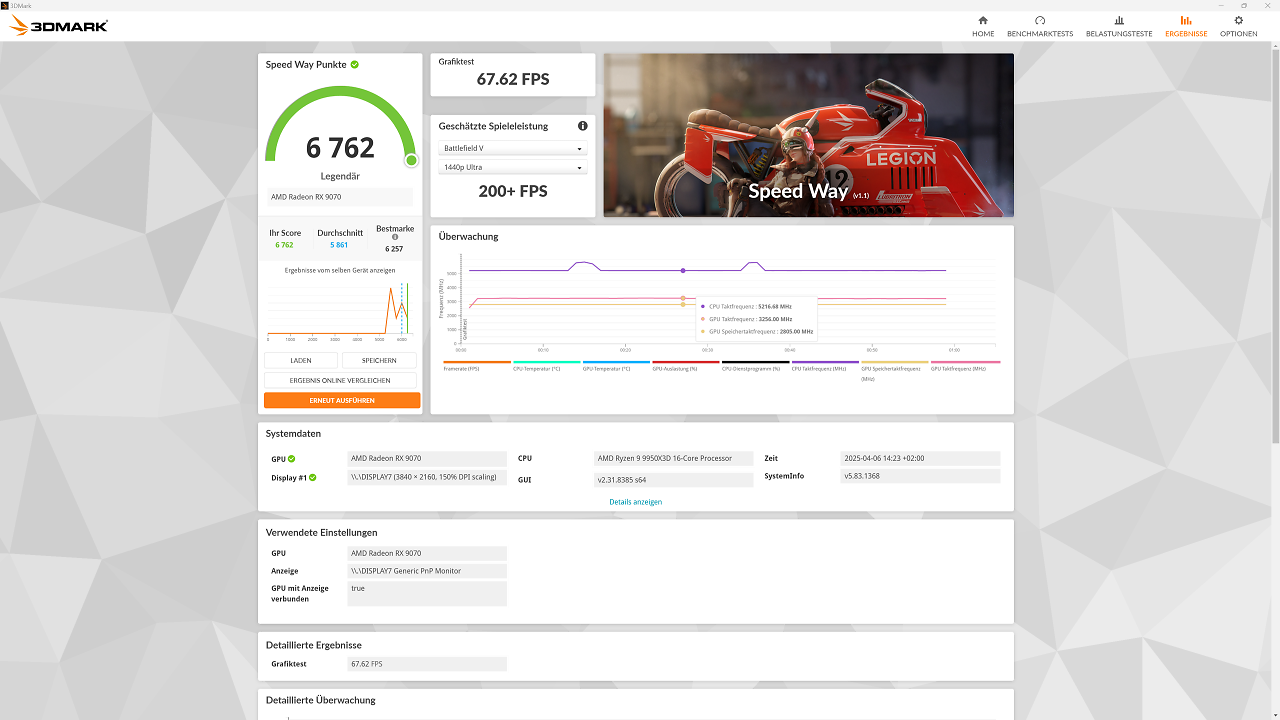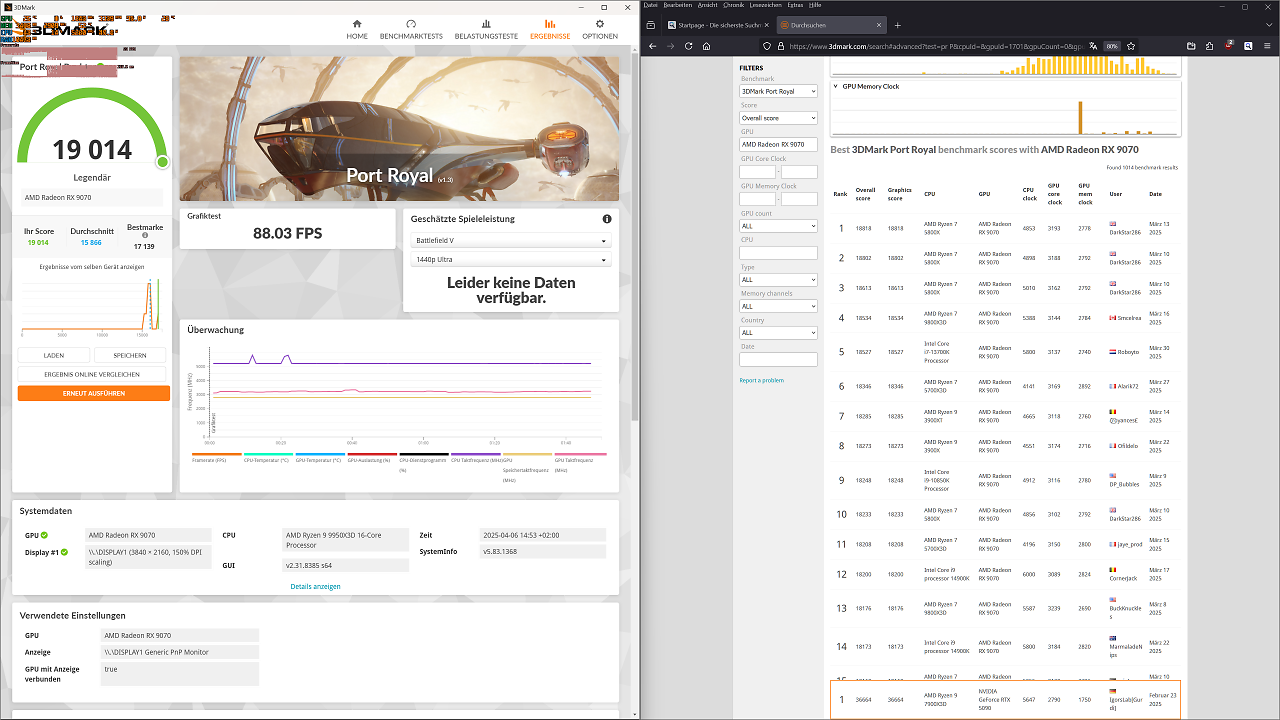AMD RX 9070 vBIOS flash offers up-to 20% performance boost — modders claim OC beats 9070 XT

Within just a month, the PC enthusiast community has already flashed the base RX 9070 with the XT's vBIOS, as reported by PCGH. In this instance, the increased TGP and clock speeds net a solid 15-20% uplift over the base configuration, and with some tuning, the RX 9070 can approach or even surpass its XT equivalent. While this is a fun experiment with tangible benefits, remember that modding your GPU's vBIOS will likely void any warranty and carries a number of risks, like bricking your GPU.
As shown in the benchmarks below, the base RX 9070 is quite power-starved, limited to a 220W TGP compared to the 304W TGP design on its XT brethren. The clock speeds also take a significant hit, dropping from 2.97 GHz (reference) to 2.52 GHz (reference). A member of the PCGH community successfully flashed his Asus Prime RX 9070 with the vBIOS of the Asus Prime RX 9070 XT, clearing the power and frequency blockade. This effectively bumped the power draw to 317W, with the boost clocks up in the 3.1 GHz range.




Across the 3DMark suite, the modded RX 9070 coupled with the Ryzen 9 9950X3D consistently achieves 15-20% higher performance than similar non-modded configurations. In addition, with some overclocking and tuning, it is reported that the user managed to beat a stock RX 9070 XT. As might be expected, some minor instabilities were observed. AMD's ULPS (Ultra Low Power State) not working was one such issue.
Both Nvidia and AMD have tightened restrictions on vBIOS modifications in recent years. Such modding is especially tricky with Nvidia's hardware, owing to a vBIOS signature check that started with the Maxwell generation, primarily to prevent fraud and scams.
With previous AMD GPU generations like Vega and RDNA 1, the firm used the same underlying chip for its top two GPUs, differentiating them mainly through disabled hardware shaders and software-locked clock speeds. Much of the same saga repeats with RDNA 4, and the mere $50 price difference makes the RX 9070 seem like an obvious upselling tactic for the RX 9070 XT.
The software aspect of earlier gen limitations could be overcome by flashing the vBIOS, allowing many Vega 56 cards to perform like Vega 64s, while bringing RX 5700 performance up to RX 5700 XT levels. However, since the missing shaders are likely fused off on the hardware level, they cannot be re-enabled through software.
If you decide to take your GPU for a spin, be aware of the obvious dangers of vBIOS modding. Likewise, keep an eye on your core, memory, and VRM temperatures as you'd be pushing over 300W across a board that's likely not designed with that figure in mind.
Get Tom's Hardware's best news and in-depth reviews, straight to your inbox.

Hassam Nasir is a die-hard hardware enthusiast with years of experience as a tech editor and writer, focusing on detailed CPU comparisons and general hardware news. When he’s not working, you’ll find him bending tubes for his ever-evolving custom water-loop gaming rig or benchmarking the latest CPUs and GPUs just for fun.
-
ohio_buckeye While stuff like this is cool to talk about, wouldn’t simply overclocking the card be better so that you aren’t voiding the warranty? Or at least the bios is not modded in the event the card has defects?Reply -
alceryes Reply
Using modded BIOS' may allow power profiles and voltages not included with the stock 9070. This will vary, gen to gen, of course.ohio_buckeye said:While stuff like this is cool to talk about, wouldn’t simply overclocking the card be better so that you aren’t voiding the warranty? Or at least the bios is not modded in the event the card has defects? -
Exploding PSU ReplyMakaveli said:I've done this on so many Radeons in the last 20 years good memories.
My Vega 56 is giggling in the corner while I read this article... Good times... -
A Stoner This seems like it should be a no brainer that this would be the result. For all intents and purposes the only real difference between the 9070 and the 9070 XT is power and clocks. Now, at an individual card and manufacturer level there could be other differences in the power delivery circuitry and other card components that could make the 9070 xt a more robust card and the 9070 less reliable at the higher frequencies and power levels, not to mention cooling.Reply
That said, the $50 difference and the cost to make custom items argues that most manufacturers are going to use common items between the cards they produce and it might really be that the only real difference is the bios on the board.
I would argue availability/price should be the driving factor in whether to use this method or not. If you need the 9070 XT performance but none are available or the XT price is significantly elevated vs the non-XT version, only then would the risk vs reward be reasonable. -
valthuer Reminds me of 2011, when I flashed the BIOS of my MSI Radeon HD 6950, effectively turning it into a 6970.Reply
First thing I did after that, was play Crysis 2.
Those were the days, man!🔝 -
TJ Hooker Reply
Well, you still get ~14% more hardware with the 9070 XT, e.g. 14% more shader cores, 14% more AI cores, etc. And performance/power tends to scale better with more hardware resources compared to increasing clock speeds.A Stoner said:This seems like it should be a no brainer that this would be the result. For all intents and purposes the only real difference between the 9070 and the 9070 XT is power and clocks. Now, at an individual card and manufacturer level there could be other differences in the power delivery circuitry and other card components that could make the 9070 xt a more robust card and the 9070 less reliable at the higher frequencies and power levels, not to mention cooling. -
tamalero Reply
I still remember that soft mods to make your X800 GTO to X850XT, the performance hike was pretty big back then.valthuer said:Reminds me of 2011, when I flashed the BIOS of my MSI Radeon HD 6950, effectively turning it into a 6970.
First thing I did after that, was playing Crysis 2.
Those were the days, man!🔝 -
DS426 I can appreciate that AMD still allows vBIOS flashing. Great mentions so far, but I'm also reminded of a time when dual- and triple-core Phenom processors could get unlocked into being quad-core parts, even if it took some tinkering around as those previously disabled cores were usually weak.Reply -
Heiro78 Reply
The 9070s seem to have two 8pin connectors vs the three 8 pin connectors that the XT versions do. And reading the article, the vBios brings TDP to 321. So it eats away at the safety factor of the two 8pins on the non-XT. But somehow still not worse than the factor of safety that the 12VHPWR connectors have.A Stoner said:This seems like it should be a no brainer that this would be the result. For all intents and purposes the only real difference between the 9070 and the 9070 XT is power and clocks. Now, at an individual card and manufacturer level there could be other differences in the power delivery circuitry and other card components that could make the 9070 xt a more robust card and the 9070 less reliable at the higher frequencies and power levels, not to mention cooling.
That said, the $50 difference and the cost to make custom items argues that most manufacturers are going to use common items between the cards they produce and it might really be that the only real difference is the bios on the board.
I would argue availability/price should be the driving factor in whether to use this method or not. If you need the 9070 XT performance but none are available or the XT price is significantly elevated vs the non-XT version, only then would the risk vs reward be reasonable.
I recall an individual 8 pin has a safety factor of 1.68 at 150 watts and the 12VHPWR of 1.14 at 600 watts
typo: 8pins not 9pins